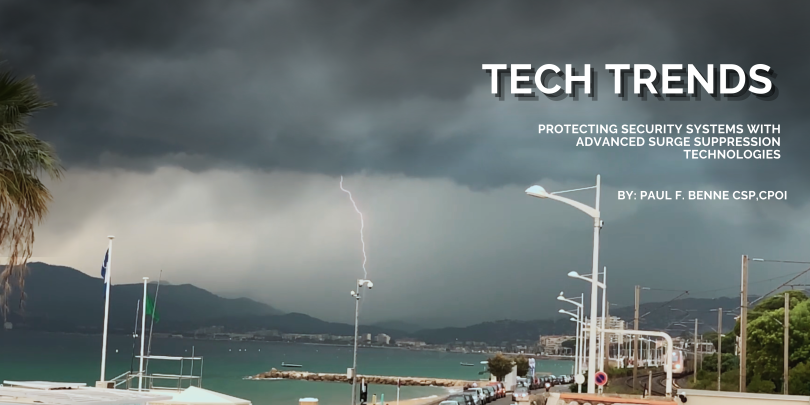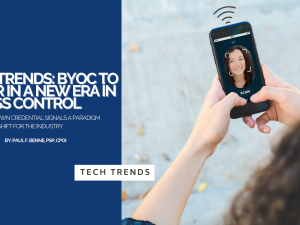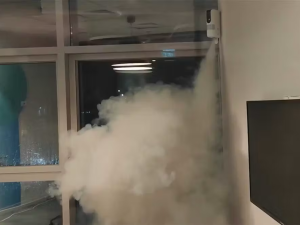Paul F. Benne
January 2025 – Security Business Magazine
In today’s interconnected world, the need to safeguard security systems from various threats has never been more critical. One of the most overlooked but potentially devastating risks to electronic systems is electromagnetic pulse (EMP) events, power surges, and lightning strikes.
These phenomena can cause significant damage to electronic components, potentially rendering security systems inoperable at times when they are most needed. Fortunately, modern technology offers advanced solutions to ensure that security systems remain operational, even during extreme events.
Before diving into the specific technologies that protect security systems, it’s important to understand the nature of these threats.
- Electromagnetic Pulse (EMP): EMP events can result from natural or man-made sources. Solar storms, for instance, can release large bursts of electromagnetic energy that interfere with electrical systems on Earth. Similarly, nuclear detonations at high altitudes create EMPs that can cripple electronic systems across wide areas. The effects are sudden and widespread, causing irreversible damage to circuits unless appropriate protection is in place.
- Power Surges: Power surges occur when there is a brief but intense spike in voltage within an electrical circuit. Common causes include problems with the power grid, such as faults or switching operations, as well as nearby lightning strikes. Surges can damage sensitive electronics by overwhelming their design capacity, resulting in component failure and system downtime.
- Lightning Strikes: Direct lightning strikes are perhaps the most recognized threat to electronic systems. With the potential to deliver millions of volts, a lightning strike can instantly destroy unprotected electronics. Even indirect strikes, which induce high voltage transients into nearby power lines or data cables, can severely damage electronic security systems.
Given these threats, it is essential for Security Consultants and Integrators to advocate for the implementation of robust protective measures, especially in critical facilities. The following technologies are among the most advanced methods available for ensuring that security systems stay operational during extreme events.
Shielding Against EMP Events
EMP shielding is one of the most critical technologies for protecting security systems from electromagnetic pulses. The key is to create a protective barrier that prevents the electromagnetic energy from reaching sensitive electronic components.
- Faraday Cages: Faraday cages are metallic enclosures that protect equipment from EMPs by blocking electromagnetic fields. This is achieved by surrounding the sensitive equipment with a conductive layer, which distributes the electromagnetic charge around the cage rather than through the equipment inside.
- EMP-Hardened Cables and Components: Another critical aspect of protecting against EMPs is ensuring that all cables and components are also hardened against electromagnetic interference. Shielded cables with appropriate grounding can prevent EMPs from entering a system through power or data lines.
- Surge Suppression and Filtering: Incorporating surge suppression devices into the power and communication lines of security systems can also help mitigate the effects of an EMP by redirecting or absorbing excess energy before it reaches sensitive electronics.
Advanced Technologies for Power Surge Protection
Power surges are a common occurrence, often caused by irregularities in the power grid or nearby electrical faults. Modern surge protection technologies have advanced significantly, offering multiple layers of defense against surges.
- Surge Protection Devices (SPDs): SPDs are designed to detect and limit voltage spikes. These devices act as a gatekeeper, allowing normal voltage to pass through while diverting surges to the ground. Modern SPDs can respond in nanoseconds to prevent surges from damaging sensitive equipment. Advanced models now come with built-in diagnostics and monitoring capabilities, allowing operators to track performance and detect when the devices need replacement before failure occurs.
- Uninterruptible Power Supplies (UPS): While primarily used to provide temporary power during outages, UPS systems also offer excellent surge protection capabilities. Modern UPS systems use sophisticated filtering technology to smooth out power irregularities, ensuring a steady and safe power supply to security systems.
- Isolated Grounding Systems: Implementing isolated grounding systems is another way to protect sensitive electronics from power surges. In an isolated grounding system, the ground circuit for sensitive electronics is separated from the building’s main grounding system. This reduces the risk of voltage surges caused by ground loops, ensuring that the security system remains unaffected by electrical noise and disturbances elsewhere in the building.
Lightning Protection for Security Systems
Lightning is a unique threat that requires specialized protective measures. Unlike EMPs and power surges, the energy released by a lightning strike can be catastrophic, requiring a comprehensive defense strategy.
- Lightning Arresters: Lightning arresters are critical devices designed to protect electrical systems from direct strikes by diverting the lightning’s energy away from the sensitive electronics. Installed at critical points where power lines or data cables enter a building, these arresters can prevent the massive voltage surges caused by lightning from traveling into the security system.
- Grounding and Bonding Systems: Effective grounding is crucial for protecting against both direct and indirect lightning strikes. A well-designed grounding system ensures that excess energy from a lightning strike is safely dissipated into the earth without causing harm to the security system. Proper bonding of metal structures and equipment within the building further helps prevent energy buildup, reducing the risk of damage.
- Transient Voltage Surge Suppression (TVSS): For indirect lightning strikes that induce surges into power lines, TVSS devices provide an additional layer of protection. Similar to SPDs, these devices limit the voltage passing through the system, ensuring that transient surges caused by lightning do not harm sensitive security equipment.
Companies like lifesafetypower.com and Altronix.com offer a host of power related products designed to supply and protect at the component level, while companies like EMPShield.com have products designed to protect everything connected to the power circuit, providing comprehensive protection.
Protecting security systems from EMPs, power surges, and lightning requires a multi-faceted approach that integrates advanced technologies. By implementing these technologies, organizations can ensure the continued functionality of their systems, even in the face of extreme electrical events. This comprehensive approach to protection is critical for maintaining security and operational integrity in today’s increasingly volatile environment.
Conclusion:
In conclusion, protecting security systems from EMPs, power surges, and lightning strikes is essential to ensure their continuous operation, particularly during extreme events. Advanced technologies such as EMP shielding, surge suppression devices, and lightning protection systems provide essential defense for electronic systems in critical environments.
Source:
Paul F. Benne, “Tech Trends: Advanced Surge Suppression Technologies,” Security Info Watch, January 20, 2025. Available at: https://www.securityinfowatch.com/integrators/power-systems-supplies/article/55250620/tech-trends-advanced-surge-suppression-technologies.







